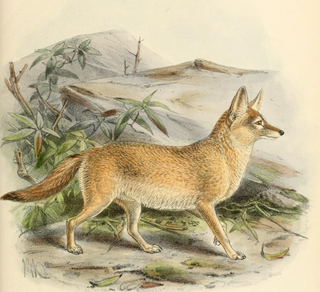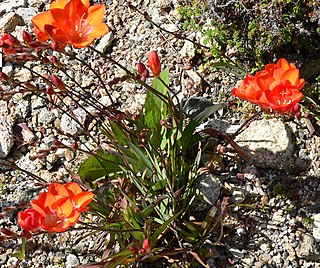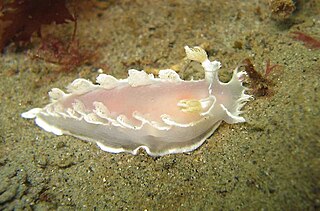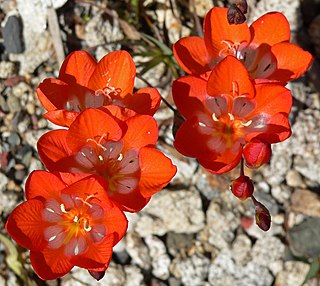
Tradescantia pallida is a species of spiderwort native to the Gulf Coast region of eastern Mexico. The cultivar T. pallida 'Purpurea' is commonly called purple secretia, purple-heart, or purple queen. Edward Palmer collected the type specimen near Ciudad Victoria, Tamaulipas in 1907.
Iris illyrica, the Illyrian iris, is a perennial plant from the iris family (Iridaceae), native to Southeastern Europe.

Joseph Salim Peress, was a pioneering British diving engineer, inventor of one of the first truly usable atmospheric diving suits, the Tritonia, and was involved in the construction of the JIM suit.

The pale fox is a species of fox found in the band of African Sahel from Senegal in the west to Sudan in the east. It is one of the least studied of all canid species, in part due to its remote habitat and its sandy coat that blends in well with the desert-like terrain.

Impatiens pallida, with the common names pale jewelweed, pale touch-me-not, or yellow jewelweed, is a flowering annual plant in the family Balsaminaceae native to Canada and the United States. It grows in moist to wet soils, generally alongside the closely related Impatiens capensis, producing flowers from midsummer through fall.

Tritonia is a genus of flowering plants in the iris family first described as a genus in 1802. They are naturally distributed across southern Africa, with a high concentration of species in Cape Province of western South Africa. The genus is closely related to the genus Ixia.

Iris pallida, the Dalmatian iris or sweet iris, is a hardy flowering perennial plant of the genus Iris, family Iridaceae. It is native to the Dalmatian coast (Croatia) but widely naturalised elsewhere. It is a member of the subgenus Iris, meaning that it is a bearded iris, and grows from a rhizome. It adapts well to different environments and is used in many different ways.

Tritoniidae is a taxonomic family of nudibranchs in the suborder Cladobranchia, shell-less marine gastropod molluscs. This family includes some of the largest known nudibranchs, with the NE Atlantic species Tritonia hombergii reaching 20 cm in length. It is the only family in the monotypic superfamily Tritonioidea.

Arctostaphylos pallida, commonly known as pallid manzanita, Oakland Hills manzanita, and Alameda manzanita, is an upright manzanita shrub from the Ericaceae, or heath family. It is endemic to the eastern San Francisco Bay Area of Northern California.

Tritonia is a genus of sea slugs, nudibranchs, shell-less marine gastropod molluscs in the family Tritoniidae.
Tritonia pallida is a species of dendronotid nudibranch. It is a marine gastropod mollusc in the family Tritoniidae.

Tritonia crocata is a plant species in the family Iridaceae.

Iris pallida subsp. cengialti is a subspecies in the genus Iris, it is also in the subgenus Iris. It is a rhizomatous perennial, from Italy and Slovenia. It has yellowish-green, glaucous, lanceolate or ensiform leaves, tall stem, green flushed with purple spathes, 2 short branches, 2–3 scented flowers, in shades of violet, blue-violet, deep purple, blue-purple, deep blue-purple, pale purple, deep blue, to mid-blue. It has a yellow or orange tipped beard. It was originally published as Iris cengialti but then re-classified as a subspecies of Iris pallida, and known as Iris pallida subsp. cengialti, but it is often still called Iris cengialti. It is cultivated as an ornamental garden plant in temperate regions.

Iris pallida subsp. illyrica, synonym Iris pseudopallida, is a subspecies of Iris pallida. It is a rhizomatous perennial from Croatia. It has flat, curved of sickle-shaped leaves, tall slender stems, 3–8 fragrant flowers, in shades of violet, or pale violet flowers, mauve, lavender, purple, yellow or white, between May and June. The iris was originally thought to be a separate species, but later classified as subspecies of Iris pallida, although in Croatia, it is still known as Iris pseudopallida. It is cultivated as an ornamental plant in temperate regions, especially in the Balkan regions.

Carya pallida, sand hickory, or pale hickory is a species of hickory native to the southeastern United States. It is a perennial, dicotyledonous plant which prefers rocky or sandy habitats. The sand hickory can reach heights of up to 30m, but its typical height is between 9-24m. In an open area, Carya crowns are usually towering and slim. The sand hickory nut is edible and consumed by various organisms.
Tritonia pallida may refer to:











